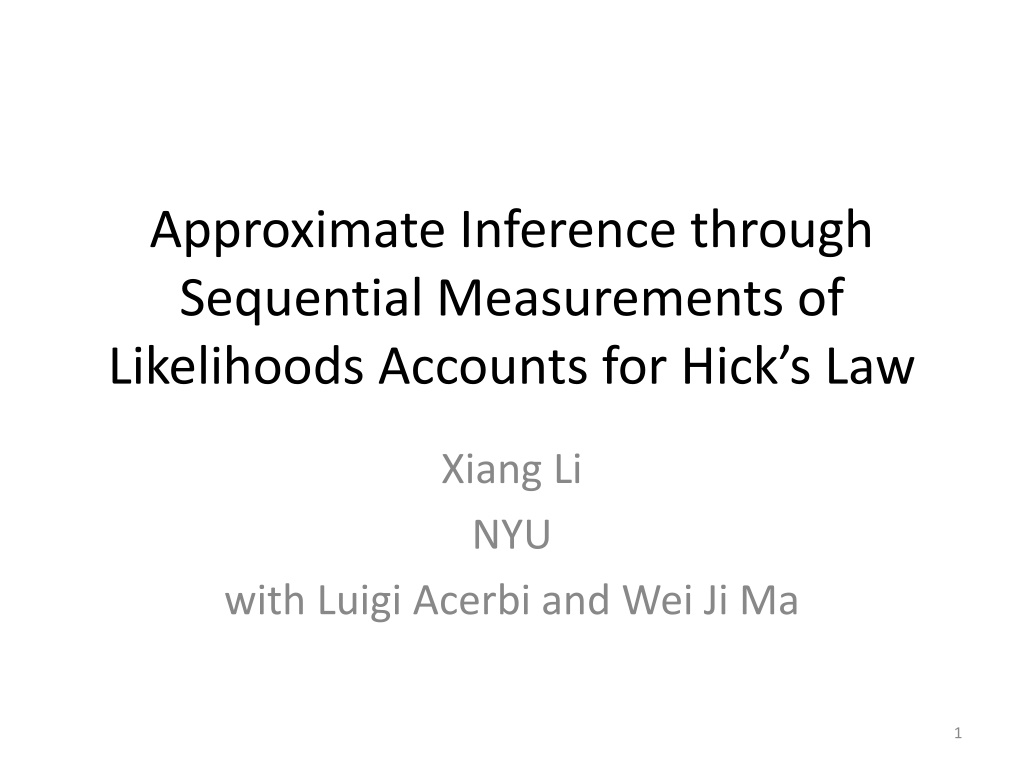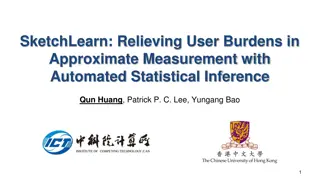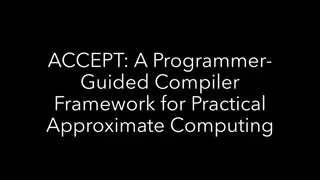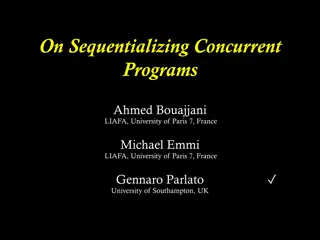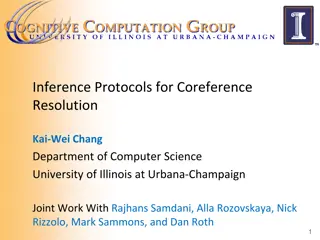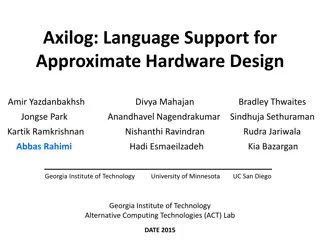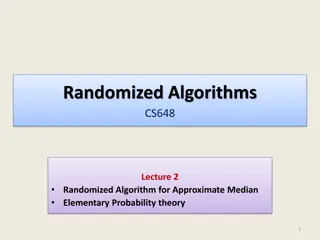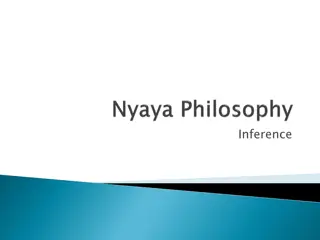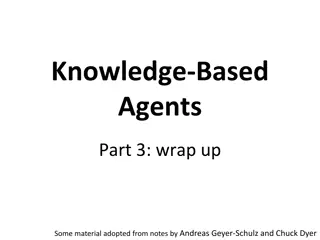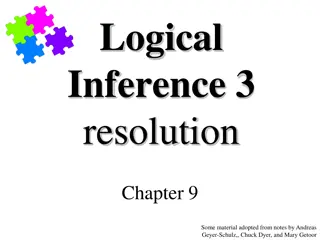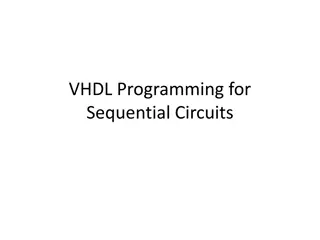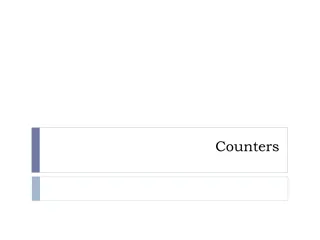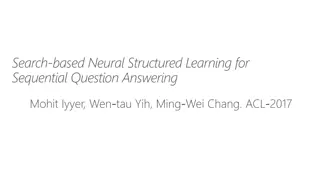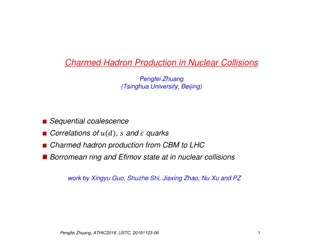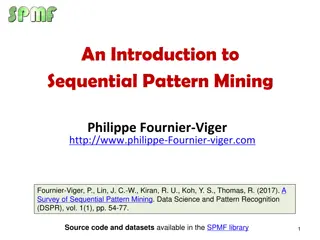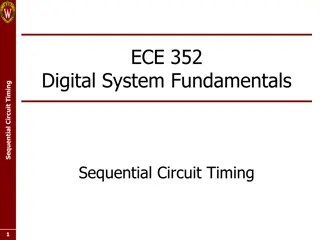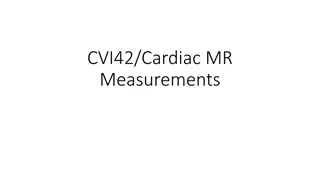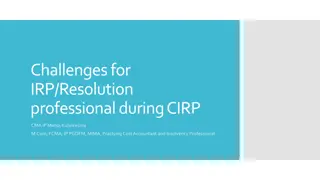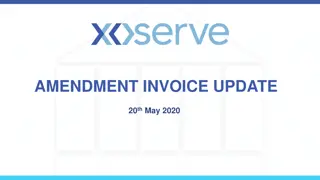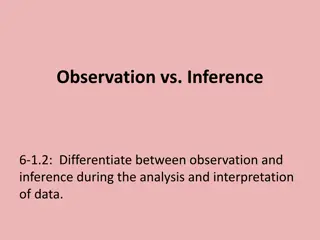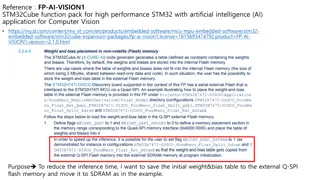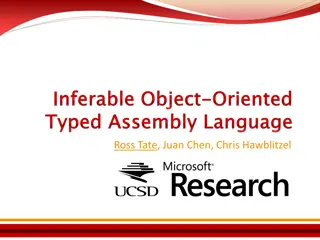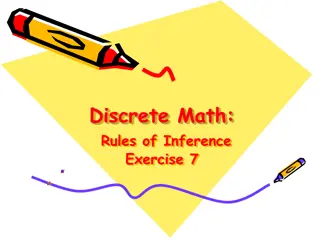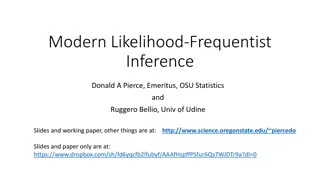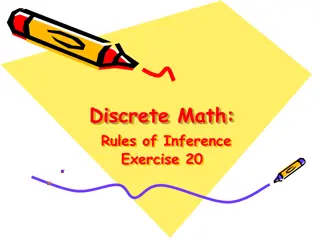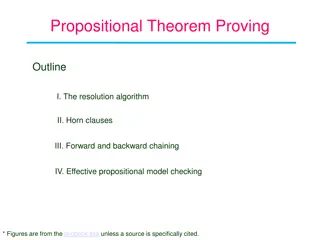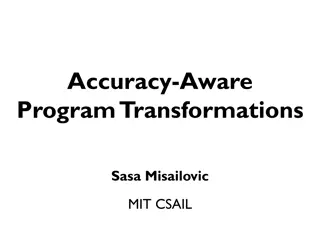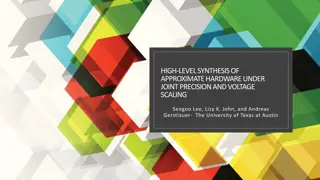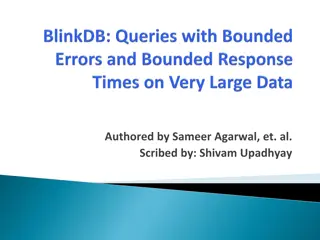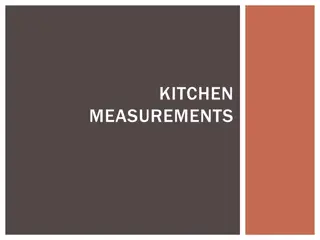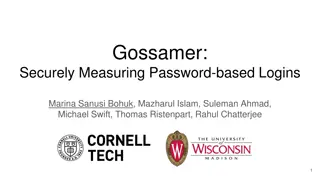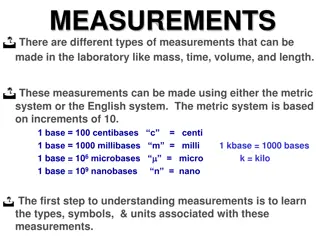Sequential Approximate Inference with Limited Resolution Measurements
Delve into the world of sequential approximate inference through sequential measurements of likelihoods, accounting for Hick's Law. Explore optimal inference strategies implemented by Bayes rule and tackle the challenges of limited resolution measurements. Discover the central question of refining approximations with costly measurements and seek active sampling strategies in this nuanced study. Related frameworks such as evidence accumulation and resource rationality provide additional context and insights into the complex world of inference.
Download Presentation

Please find below an Image/Link to download the presentation.
The content on the website is provided AS IS for your information and personal use only. It may not be sold, licensed, or shared on other websites without obtaining consent from the author. Download presentation by click this link. If you encounter any issues during the download, it is possible that the publisher has removed the file from their server.
E N D
Presentation Transcript
Approximate Inference through Sequential Measurements of Likelihoods Accounts for Hick s Law Xiang Li NYU with Luigi Acerbi and Wei Ji Ma 1
Which category did the black dot come from? Li & Ma (2017) 2
Inference among multiple categories Li Pi= Optimal inference is implemented by Bayes rule which maximizes probability correct k Lk 3
Inference among multiple categories Li Pi= Optimal inference is implemented by Bayes rule which maximizes probability correct k Lk What if inference has limited resolution ? Specifically, we assume that the likelihoods can only be measured in a noisy way. 4
Inference among multiple categories Li Pi= Optimal inference is implemented by Bayes rule which maximizes probability correct k Lk What if inference has limited resolution ? Specifically, we assume that the likelihoods can only be measured in a noisy way. Central question of the project How to sequentially refine the approximation if each measurement is costly? We are looking for an active sampling strategy. 5
Related frameworks Evidence accumulation (Wald & Wolfowitz, 1948; Ratcliff, 1978): but not Bayesian 6
Related frameworks Evidence accumulation (Wald & Wolfowitz, 1948; Ratcliff, 1978): but not Bayesian Resource rationality (Griffiths, Lieder, & Goodman, 2015): but they sample from a known posterior. We gradually approximate the posterior. 7
Related frameworks Evidence accumulation (Wald & Wolfowitz, 1948; Ratcliff, 1978): but not Bayesian Resource rationality (Griffiths, Lieder, & Goodman, 2015): but they sample from a known posterior. We gradually approximate the posterior. Information sampling (Oaksford and Chater, 1994): but this is sampling directly from the environment. We work at a more abstract level. 8
Related frameworks Evidence accumulation (Wald & Wolfowitz, 1948; Ratcliff, 1978): but not Bayesian Resource rationality (Griffiths, Lieder, & Goodman, 2015): but they sample from a known posterior. We gradually approximate the posterior. Information sampling (Oaksford and Chater, 1994): but this is sampling directly from the environment. We work at a more abstract level. Bayesian optimization (Jones, Schonlau, & Welch, 1998): machine learning technique to choose a sequence of parameter combinations to evaluate 9
Inference from observation N categories Each observation is informative only about one category 10
Inference from observation N categories Each observation is informative only about one category ( ) ( )= p xiC = Ci Likelihood of the ith category is the set of observations made for ith category Lixi ix 11
Inference from observation N categories Each observation is informative only about one category ( ) ( )= p xiC = Ci Likelihood of the ith category is the set of observations made for ith category Lixi ix Li Posterior of the ith category Pi= k Lk 12
Abstraction step Now forget about the raw observations xi and think about the likelihoods Li abstractly 13
Abstraction step Now forget about the raw observations xi and think about the likelihoods Li abstractly Li Pi= Posterior of ith category: k Lk 14
Abstraction step Now forget about the raw observations xi and think about the likelihoods Li abstractly Li Pi= Posterior of ith category: k Lk Key concept: Instead of explicitly modeling noisy observations from the environment, we model noisy measurements of the likelihood. jth measurement of ith likelihood: lij Assume lognormal noise: ( )= Normal loglij;logLi,s2 ( ) p loglijLi Assume conditional independence 15
Additional assumptions Prior over the likelihoods Li ( ) ( )= Normal logLi;mL,sL 2 p logLi 16
Additional assumptions Prior over the likelihoods Li ( ) ( )= Normal logLi;mL,sL 2 p logLi A sequence of actions in discrete time Action set: at each time step, the agent has two possible actions: Decide on a category and receive a reward for correctness Make a new measurement: select a category, receive one measurement from that category, pay a cost, go to next time step 17
Summary of the problem There are true posteriors but those are unknown to the agent. 18
Summary of the problem There are true posteriors but those are unknown to the agent. Given a prior over likelihoods Li, noise in the measurements of Li, a reward for correctness, and a cost per measurement, what is a good policy? 19
Summary of the problem There are true posteriors but those are unknown to the agent. Given a prior over likelihoods Li, noise in the measurements of Li, a reward for correctness, and a cost per measurement, what is a good policy? The Bellman equations are intractable. Therefore consider myopic policies instead (thinking one step ahead) 20
Approximate algorithm Step 1. Based on current noisy measurements of all likelihoods, calculate a posterior distribution over each category likelihood {L1, ... , Ln} 21
Approximate algorithm Step 2. Use those to calculate a posterior distribution over the posteriors {P1, ... , Pn} 22
Approximate algorithm Step 3. Based on that posterior, calculate a posterior distribution over the max posterior M=max {P1, ... , Pn}. We denote this by p(M|data). M 23
Approximate algorithm Step 4. Consider each category a candidate for making another measurement. Separately for each category i, simulate a new measurement from that category based on current knowledge (Thompson sampling) Calculate the reduction Ri in Var(M|data) due to this simulated measurement. Step 5. Is max{R1, ,Rn} > threshold? If so, choose argmax category to make a new measurement from. Make an actual measurement. Go back to Step 1. If not, decide: choose the category that maximizes [Pi]. 24
Result high Sampling cost low 25
Hicks law Hick, 1952 26
Hicks law Found experimentally in light detection (Hick, 1952), dual tasks (Damos & Wickens, 1977), pitch judgment (Simpson & Huron, 1994), key strokes (Logan, Ulrich, & Lindsey, 2016) Has been explained in terms of competing race model (Usher & McClelland, 2001) and a memory-based model (Schneider & Anderson, 2010) 27
Conclusion We conceptualized approximate inference as a process of making noisy measurements of category likelihoods (one category at a time). A myopic iterative measurement policy shows a relationship between the number of iterations and the number of categories that resembles Hick s law. 28
Open questions and possible extensions More direct experimental evidence? Assumption that each observation is informative only about one category Other stopping rules Other acquisition functions Memory decay Relation with other models 29
